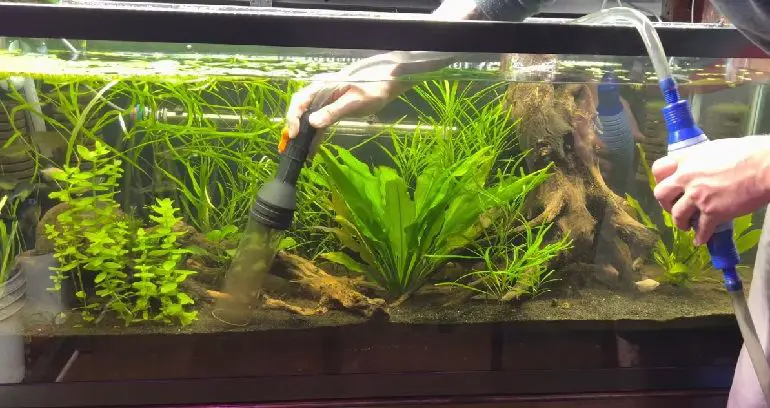Sand can be difficult to clean in an aquarium, but with the right tools and techniques, it can be managed. The small grain size of sand means debris, waste and algae can easily get trapped, so regular cleaning is important. However, sand also provides benefits like a natural look and substrate for plants and burrowing species.
Page Contents
Why is sand hard to clean?
There are a few reasons why sand can be challenging to clean in an aquarium:
- Small grain size – Sand particles are tiny, so debris, fish waste and uneaten food can easily fall between the grains and become trapped.
- Compaction – Over time, sand can become compacted, especially under decorations and in high traffic areas. This causes waste to accumulate in the substrate.
- Difficult to siphon – Sand is too heavy to be sucked up by a gravel vacuum during routine water changes. This makes removing debris from the substrate itself more difficult.
- Anaerobic pockets – If waste builds up deep in the sand bed, it can create anaerobic bacteria pockets that release harmful hydrogen sulfide gas.
- Cloudiness – Agitating the sand bed during cleaning can stir up particles and make the water cloudy temporarily.
With proper maintenance techniques, these issues can be prevented or managed.
Cleaning sand during water changes
Here are some tips for cleaning aquarium sand when performing routine partial water changes:
- Use a gravel vacuum or siphon to remove debris sitting on top of the sand. Place the siphon end just above the surface – don’t dig into the sand.
- Target areas around decorations, plants and other high waste zones. Rotate which sections you focus on each week.
- Gently wave the siphon over the sand surface to stir up debris so it can be extracted.
- Use your fingers or a chopstick to gently disturb areas of packed sand and release trapped debris before siphoning.
- Avoid moving decorations and disturbing large portions of the substrate at once to prevent excessive cloudiness.
- Remove only around 25% of the water volume at a time to minimize disruption of the sand bed.
- Increase water movement after cleaning to help suspend any particles in the water column where they can be filtered out.
Deep cleaning the sand substrate
Over time, deeper cleanings of the actual sand bed may be needed to remove accumulated detritus. Some options include:
- Sand sifting creatures – Adding bottom dwellers like cory catfish, loaches or shrimp can help turn over and aerate the substrate.
- Gravel vacuum – During routine cleaning, use the gravel vacuum to gently disturb and extract debris from deeper layers.
- Partial sand removal – Remove, clean and replace the top 1-2 inches of sand where most waste accumulates.
- Complete breakdown – Removing all substrate to clean the entire sand bed is thorough but labor intensive.
- Hydrogen peroxide – Spot treating areas of gas buildup with diluted hydrogen peroxide can help break down trapped organic material.
Avoid disturbing too much of the substrate at once and be prepared to manage cloudy water when doing deep sand cleans.
Best practices for maintaining sand
Incorporating sand-friendly equipment and habits when setting up and maintaining an aquarium can reduce overall cleaning requirements:
- Layer substrate – Covering sand with a shallow top layer of gravel helps trap debris before it sinks into the sand.
- Plant heavily – Aquatic plants help stabilize the substrate and their roots oxygenate the sand for less gas buildup.
- Shallow bed – Keep sand beds under 3 inches deep to avoid deep pockets of debris.
- Efficient filter – Use a high quality filter appropriate for the tank size to better capture fine particles.
- Alter water flow – Direct powerheads or air stones at the sand surface to prevent dead spots.
- Reduce bioload – Don’t overstock the tank to limit waste accumulation in the substrate.
- Clean often – Frequently removing excess debris keeps it from building up in the sand.
Conclusion
While sand substrates require more maintenance than gravel or larger grains, developing good aquarium husbandry techniques makes it manageable. With routine cleaning, high filtration and other best practices, sand makes an attractive and natural-looking substrate.
